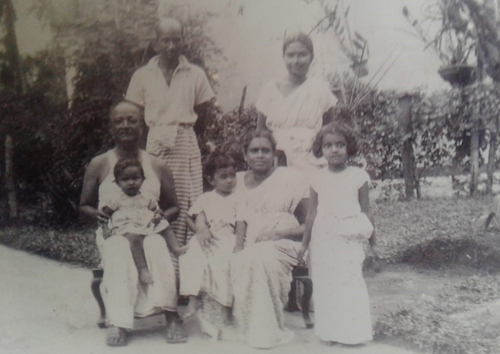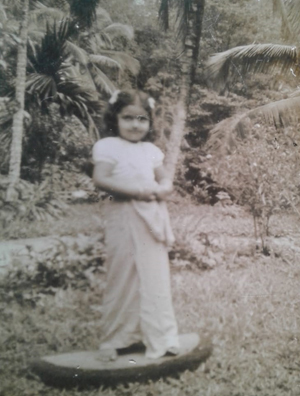When the village came together for Aluth Avurudda

The writer (left below), dressed up for Avurudu as a little girl and with her family--parents, grandparents and brothers at Meewatura
As a child I lived with my grandparents in Meewatura, a village close to Peradeniya and my mind goes back to the Aluth Avurudu I spent there. I vividly remember the paddy harvest season; the rains came at the right time and the farmers had a good harvest to celebrate the Aluth Avurudda.
Many cultural practices are connected with the paddy harvest and the Sinhala New Year.
The Maha paddy harvest ends just before the Aluth Avurudda. This is a time of prosperity for the farmers who look forward to celebrating the Sinhala and Tamil New Year with their bountiful harvest. But this year with all the financial hardships faced by the people due the country’s cash crunch, will the New Year celebrations be the same? This is the million dollar question posed by most as the Sinhala Aluth Avurudda (New Year) and Puthandu (Tamil-Hindu New Year) dawns on the 14th.
 April in the Gregorian calendar is known as Bak, the first month of the year according to the Sinhala Almanac. The word Bak has been derived from the Sanskrit word Bhagya which means plenty, the season of spring or the Vasantha Kalaya.
April in the Gregorian calendar is known as Bak, the first month of the year according to the Sinhala Almanac. The word Bak has been derived from the Sanskrit word Bhagya which means plenty, the season of spring or the Vasantha Kalaya.
Astrology plays a major role in the Aluth Avurudu celebrations. From the time of seeing the new moon upto the time people leave for work in the new year, a nekatha – an auspicious time is given to perform all the special activities associated with the Aluth Avurudu.
Appuhamy, Loku Menika, Muthu Banda, Dingiri Menika, Heen Banda and many other members of the farming families would visit my grandparents’ home to do various chores and gossip with Heen Menika, our cook. They were paddy cultivators – andé farmers (they worked on another’s land and shared the harvest with its owner)and always looked forward enthusiastically to the dawn of the New Year once they completed their harvest.
When it was time to harvest, they would come with a penuma – a tray of sweetmeats with kevum, kokis, aggala etc., a bunch of bananas, and a sheaf of betel leaves to inform the owner that they would be harvesting the paddy. Many families in the village joined to help the farmer in his work from the time of re-planting until the harvest.
On the scheduled day, the goyam kepeema, villagers would gather in the field to help the farmer. At noon, the farmer would bring the muttettu – the afternoon meal from his home and feed the people either seated under a tree or in a temporary hut. The harvested paddy was taken to the kamatha (threshing floor). In the evening, buffaloes were brought for the goyam pageema (to extract the seed).The owner would be present at the threshing floor. Lantheruma (hurricane lamps) were used to light the area. First, a mature buffalo was driven on to the floor and gradually the number was increased by tying one buffalo at a time to the first buffalo – about four or even six if it was a large crop. A man with a stick would guide the team of animals to walk round and round on the harvested paddy. When he wanted the animals to stop, he shouted the command “Hoe, hoe, hoe” but would speak kindly, addressing them as kiri amma, kiri putha or kiri duwa like family members.
There was a special form of recitation the farmers used when they worked on their fields such as nelum kavi (singing while re-planting). There were boys who collected gom pas (cow dung) buffalo droppings, alert to quickly pick up a kola ahurak (handful of straw) to collect the droppings so that it did not get mixed with the paddy! As children we were initially amused but later got used to it.
Once the paddy was threshed, the women would winnow it using the kulla (winnowing fan)and heap it on a side of the threshing floor. The work went on till late and the paddy was covered with straw. The owner then invited all who worked for the post muttettuwa (dinner), where karawala badun (fried dry fish), wattakka (pumpkin), mellun (leafy curry), other curries like polos ambul, (young Jak fruit) would be served. The betha meneema (measuring of the paddy) was done on the following day to be shared between the cultivator and the landowner. Once the work was complete, the paddy was taken to the atuwa (silo/stores) to be kept for use until the next harvest season.
The red blossoms of Erabadu and the call of the Koha are familiar signs associated with the advent of the New Year. With the end of the harvest, the villagers would prepare to celebrate the Aluth Avurudda. by cleaning and whitewashing their houses. Most houses then did not have cemented floors so a new coat of cow-dung was applied on the hearth and floor. Walking on this floor was a very comfortable feeling. There was Pusumba and her daughter Suraganie who came to our house to pound the paddy and they took their share as payment. Andiris would bring Telijja, the sweet toddy, the sap from the Kitul tree to make treacle and jaggery. Women would go in search of firewood and prepare to make the avurudu kevili (sweetmeats).
My aunt would be at the machine for hours as villagers came to our house to get their clothes stitched, the cloth and jacket, sarongs, and frocks for their daughters. On the parana avurudda, the day before the Aluth Avurudda, relatives would come with sweetmeats like konda kavun, athirasa, aggala, asmi, kokis, aluva, unduvel and of course, a comb of bananas. Some would even bring rice and curry in a kurini pettiya (a type of basket). All would bring a sheaf of fresh betel leaves – a bulath atha to greet the elders, worship them and seek their blessings. Neighbours and friends too would bring trays laden with sweetmeats and revive their friendship.

The family home at Meewatura: A hub of activity during Avurudu in the past
The New Year dawns when the Sun moves from the zodiac sign of Pisces to Aries (Meena Rashiya to the Mesha Rashiya). The time during this transition is the Nonagathé/punya kalaya. It is the time to stop all form of work and visit the temple for religious observances. Once they return home, they play indoor games such as bellan demeema and outdoor games. Young girls are seen on the swing while women play the rabana (a round drum kept flat on stands) singing raban kavi and competing with each other. The burst of firecrackers heralds the dawn of the Aluth Avurudda and the raban playing is more intense.
For all the New Year activities, there are auspicious times. The lady of the house prepares kiribath (milk rice) in a new clay pot which is the first meal for the new year. Milk is boiled, ganu-denu (money transactions) are made and gifts are exchanged. Finally they sit at table to enjoy a sumptuous Aluth Avurudu meal.
The anointing ceremony takes place a few days later when the villagers visit the temple where the monk has medicinal oils prepared for this custom. These enjoyable New Year celebrations of days gone by are memories to be cherished.
But now, there are very few old families living in the village. It is difficult to find people to work in the fields and they have to find paid labour. The modern farmer has a mobile telephone and when it is time to harvest the paddy, he telephones the owner to inform him about it! Harvesting is done with machines and not buffaloes. The paddy is divided by the cultivator and the owner’s share is kept until he comes to collect it. Or, if he requests, it is sold and the money is deposited in his bank account!
Even the ne gaman (where relatives visit their families) have reduced. People say they prefer to be in their own homes to celebrate the Aluth Avurudda. Women prefer to buy the new year sweetmeats rather than toil in their kitchen making them.
I remember my grandmother telling us how the village got its name. There was once a great flood and the vee (paddy) was washed off by the flood waters “vee wature giya”. The village came to be known as Veewatura and later Vee became Mee and is now Meewatura! Times have changed and some of the beautiful terraced paddy fields of my childhood have been replaced by houses and even a garage. The old rituals and customs that brought families together and strengthened relationships with neighbours and friends are fading away.
Searching for an ideal partner? Find your soul mate on Hitad.lk, Sri Lanka's favourite marriage proposals page. With Hitad.lk matrimonial advertisements you have access to thousands of ads from potential suitors who are looking for someone just like you.


